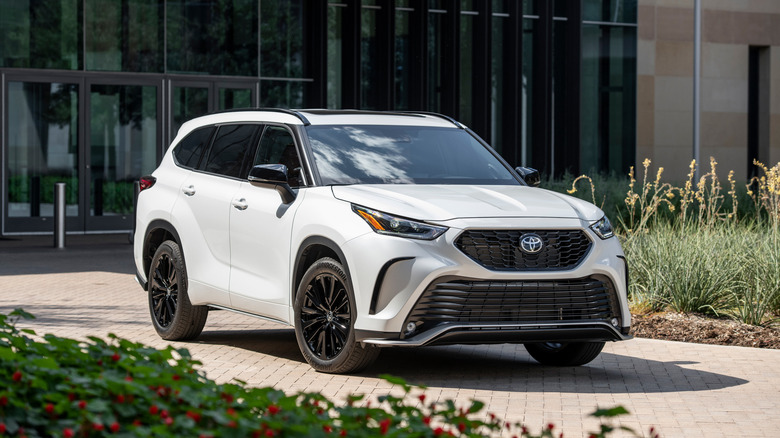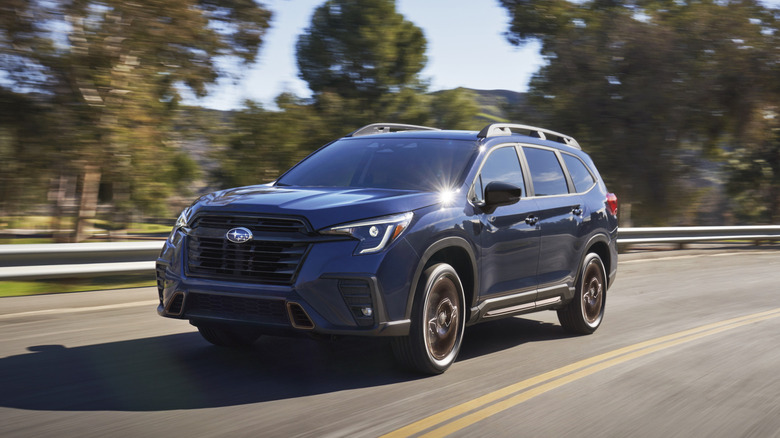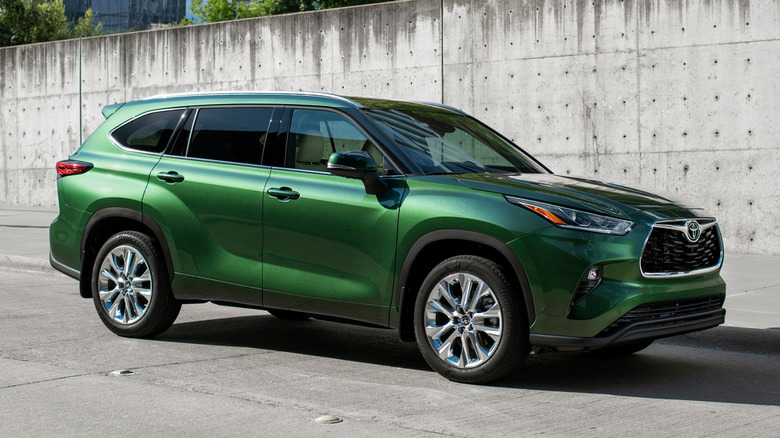Subaru Ascent Vs. Toyota Highlander: What's Different Between These 3rd-Row SUVs?
If you're looking for spacious, comfortable, and well-equipped family SUVs, the Subaru Ascent and Toyota Highlander are a great place to start that search. Both offer seating options for seven or eight passengers, lots of cargo space, and modern tech that's sure to keep the family entertained on long road trips. The Subaru, for example, has as much as 75.6 cubic feet of cargo space with the second and third row folded (17.8 cubic-feet behind the third row), while the Toyota offers 84.3 cubic feet with both rear rows folded (and 16 cubic-feet behind an upright third row). While they aren't as stout as truck-based SUVs like the Chevy Suburban we road-tripped earlier this year, both the Subaru and the Toyota can pull medium-sized trailers while also transporting your medium-to-large-sized family.
With lots of ground clearance and standard all-wheel drive, the Subaru stands out as the likely choice for off-road enthusiasts. It isn't the most off-road capable model that Subaru sells, but it will certainly get you well off the beaten path. In our review of the Toyota Highlander, it impressed us with luxury trimmings and its upscale interior, plus it offers a bit more overall cargo space than the Ascent — but is that enough to keep pace with the adventure-ready Subaru? What about power, fuel economy, and pricing? Let's take a closer look.
Power, towing capacity, and fuel economy
Under the hood of the Ascent is a turbocharged 2.4-liter four-cylinder engine that makes 260 horsepower and 277 lb-ft of torque — healthy numbers for this class. According to the EPA, the standard Ascent will return as high as 22 mpg combined (20 city/26 highway), while the upper trim levels will return 21 mpg combined (19 city/25 highway). According to Subaru, the Ascent can tow as much as 5,000 pounds –an all-time high for the brand. These are respectable numbers when you consider the Ascent's capability, but competitors like the Highlander do better.
There are two different powertrains available for the Toyota Highlander. The first is a turbocharged 2.4-liter four-cylinder engine that produces 265 hp and 310 lb-ft of torque. It's available in front-wheel drive and all-wheel drive configurations and can tow as much as 5,000 pounds – a pound-for-pound match for the Ascent. According to the EPA, FWD models will return as high as 25 mpg combined (22 city/29 highway), while AWD models can return 24 mpg combined (21 city/28 highway).
The real fuel economy winner, however, is the Highlander hybrid, which is a three-row SUV with some of the best fuel economy numbers out there. It's powered by a 2.5-liter four-cylinder engine and a hybrid system that combine for a total power output of 243 hp and 175 lb-ft, but the EPA estimates it will return 35 mpg combined on every trim level. That's very impressive for such a spacious and sizable three-row SUV.
Pricing and features
Base, front-wheel drive LE trim levels of the Highlander start at $40,970 (including $1,450 destination fee) and adding all-wheel drive to the mix raises the price by $1,600. The top-trim Platinum Highlander Hybrid has a starting msrp of $55,125. Features like an 8.0-inch infotainment screen, cloth upholstery, eight-passenger seating configuration, a six-speaker stereo and tri-zone automatic climate control are all standard on base trim levels. All Highlanders come with a pretty robust set of driver aids too like lane departure warning, adaptive cruise control, and pedestrian detection. The top Platinum trim includes the bigger touchscreen, leather upholstery, heated-and-ventilated seats, the option for seating just seven passengers, and many more creature comforts.
The 2025 Ascent has a starting price of $40,215 (including the $1,420 destination fee), with top Onyx Edition Touring models tipping the scales at $51,415. The Ascent offers all-wheel drive as standard and its big touchscreen on all models, an 11.6-inch unit, as well as standard features like adaptive cruise control, lane-keep assist, and pre-collision braking. Feature for feature, the base trim levels of these two SUVs are pretty even.
At the top of the range, the Ascent doesn't offer a hybrid powertrain, so it's less expensive than the equivalent Highlander Hybrid, but it does have similar equipment like heated-and-ventilated seats, premium leather upholstery, and seven-seater configurations. In a head-to-head battle, these two are evenly matched when it comes to price and features, but the Highlander offers a slight edge thanks to its available hybrid powertrain.


